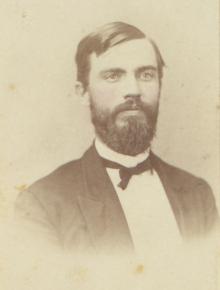- Home
- Archival Material
- College History Projects
- Subject-Based Digital Projects
John Keagy Stayman (1823-1882)

John Stayman was born on September 28, 1823 in Cumberland County, Pennsylvania. In the matriculation register of Dickinson College in Carlisle, Pennsylvania, he listed an Eliza L. Stayman under the title of Parent or Guardian. During his years at Dickinson, Stayman was a member of the Union Philosophical Society. He graduated with the Class of 1841.
In 1845, Stayman was an assistant in the Grammar School, but doubts about his teaching abilities led President John Durbin to remove him from the teaching staff. Stayman then turned to music, giving lessons in Carlisle and Harrisburg for ten years. In 1861, he returned to the College as an adjunct and then full professor of Latin and French. From 1867 to 1869 he was the professor of ancient languages, and was professor of philosophy and English literature from 1869 to 1874.
Stayman also served as the secretary of the Board of Trustees from 1865 until he was replaced by Professor Charles Himes, Class of 1855 and treasurer of the College. He retained his position as college librarian from 1865 until his resignation. Within a few years funding for the library was severely cut, while funding for the new science programs, headed by Himes, grew dramatically. In 1872 James McCauley, Class of 1847, became president of the College, and he quickly associated himself with Himes and Professor Henry Harman, Class of 1848. Stayman and two other professors, Samuel Hillman and William Trickett, found themselves outside the paths of power at Dickinson.
For a combination of personal and professional reasons, McCauley and Himes planned to rid the College of Stayman, Hillman and Trickett. At the June 1874 Board of Trustees meeting, they intended to have all faculty positions declared vacant, and then replace the three offending professors with handpicked applicants. McCauley and Himes secretly obtained the names of interested replacements, but rumors circulated around campus. One candidate, Mr. Fisher, a friend of Trickett, revealed the plot. On June 24, 1874, a “committee on lack of harmony in the faculty” presented a resolution declaring all professorships vacant. Upon approval, a committee of three, headed by McCauley, would “reconstruct” the faculty. Professors Himes and Harman were retained. Rittenhouse was to replace Staymen in English literature, Lippencott to replace Hillman in mathematics, and Fisher to replace Trickett in modern languages.
Controversy embroiled the College. Regional newspapers and alumni denounced the actions of the Board. Rittenhouse refused the position at Dickinson, fearing to be mired in a scandel. He in turn was replaced by Charles Little. Trickett filed a writ of quo warranto against Fisher, forcing him to show by what right he held Trickett’s position. The court decided in Trickett’s favor on October 17, 1874, prompting Stayman and Hillman to file similar law suits. As the college charter at that time allowed professors to only be discharged in the case of misconduct or breach of the laws of the college, the Board capitulated by offering each man a year’s pay in return for his resignation.
Stayman, Hillman, and Trickett accepted. Stayman moved to Baltimore where he started the firm of Sanders and Stayman. He remained there until his death on July 4, 1882.
Date of Post:
2005
College Relationship:
Alumnus/Alumna Class Year:
Faculty - Years of Service:
1861-1874